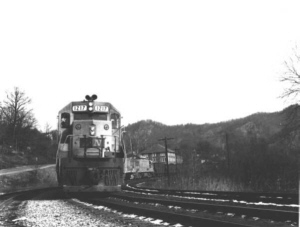
T H E P R O T O T Y P E |

Colorful Interstate RS3s line-up at Appalachia, VA in 1964 - Ron Flanary Photo
First, let me mention that I would have never modeled the Interstate if it weren't for the phenomenal work Ed Wolfe and his father Hugh have done in capturing the history and operations of the Interstate in their series of outstanding books on the Interstate Railroad. Thank you, Ed and Hugh and all the Interstate employees who contributed to the rich history in those books!
The Interstate Railroad was an 88 mile long coal-hauling shortline set in the hills of southwestern Virginia. The IRR was incorporated on February 18, 1896 by the Virginia Coal and Iron Company to provide transportation of coal from several mines in Wise County, Virginia to a connection with the L&N at Appalachia, VA. The coal in this region was considered excellent for "coking" for use in the steel industry. Within three decades, the Interstate had expanded eastward and established connections with the Southern at Appalachia, the N&W at Norton, VA, and the Clinchfield at Miller Yard, VA.

The Interstate made its money three ways. First, it earned revenue by serving dozens of local tipples located on several of its branchlines. Second, it earned revenue by moving a steady bridge traffic from the L&N at Dorchester Jct. to the L&N's partner, the Clinchfield, at Miller Yard. Finally, it earned revenue through per-diem charges on its sizeable hopper fleet. Even though the Interstate was small, it owned thousands of hoppers, and most hoppers stayed off home rails enough delivering coal that they earned a large amount of revenue. In fact, some years, the per diem from the hopper fleet was the only thing that kept the Interstate in the black.
While the Interstate dieselized in 1953 with a handful of Alco RS3s, its fleet of 50 ton hoppers was growing old and obsolete. Rather than face the daunting task of acquiring a new hopper fleet, the Interstate was put-up for sale. Both the L&N and Southern placed bids worth over $15 million. On the day of the sale, the difference between the two bids was less than $25,000, but the Southern won, and ownership was transferred in October
of 1960. From 1960 until 1965, things were status-quo on the Interstate, but on September 10, 1965, the Southern shut down its Appalachia yard and moved into Andover. The Interstate's bright orange, gray and cream RS3s were soon moved south to work as yard engines in cities like Atlanta.
The Southern initially used old F-units on Interstate mine runs through the '60s. These engines were HATED by Interstate crews because they offered poor visibility and were difficult to climb in and out of for switching duties. In the late 60s, the Southern began placing GP38s on the Interstate's mine runs. Also, in the late-1960s, an enormous transloading facility was built on top of the ex-Southern yard at Appalachia by Westmoreland coal. This facility became the terminus for many single car loadings from Interstate tipples. These short-haul cars were known as "yellow balls" and were generally smaller, older 50-ton cars from the Interstate or hand-me-down 50- and 70-ton cars from the Southern. The transloader became a major loading point for Southern unit trains.
|
When the energy crisis and subsequent coal boom of the 70s hit, the Interstate was not prepared to handle theonslaught of new traffic. L&N coal traffic bound for the Clinchfield picked up, but Southern management was not as interested in moving these cars in a timely manner like the old Interstate management, so in June, 1973, the L&N entered into a trackage rights agreement with the N&W to run its trains through Norton to the N&W's connection with the Clinchfield at St. Paul, VA. The Interstate line was still used for Plate "C" or larger cars which would not fit through the tight N&W tunnels until it was abandoned in 1985.
The Interstate was absorbed into the Norfolk Southern in 1982, and while most of the trackage is still active, the Interstate ceased to exist as a separate entity on October 31st, 1985 when control was transferred to the Clinch Valley Extension of the NS Pocahontas Division.
Source: Interstate Railroad by Ed Wolfe
Click here to learn more about the layout.
site links: home | prototype | layout | operations | modeling | photos | crew

